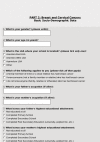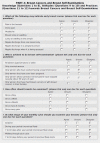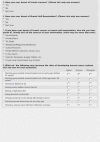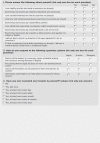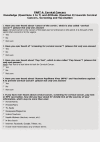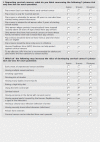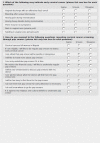Tackling breast cancer in developing countries: insights from the knowledge, attitudes and practices on breast cancer and its prevention among Nigerian teenagers in secondary schools
- PMID: 30656231
- PMCID: PMC6319123
- DOI: 10.15167/2421-4248/jpmh2018.59.4.964
Tackling breast cancer in developing countries: insights from the knowledge, attitudes and practices on breast cancer and its prevention among Nigerian teenagers in secondary schools
Abstract
Background: Breast cancer occurrences in developing countries are gradually matching caucasian levels. Since early detection is linked to reductions in morbidities and mortality, affordable screening techniques like breast self-examination (BSE) becomes imperative in these resource-limited economies. Ascertaining the Knowledge, Attitudes, and Practices (KAP) of breast cancers and BSE among young adult females will help provide baseline information for early and targeted interventions.
Method: A cross sectional survey involving 432 female senior secondary school students in Otuocha Educational Zone of Anambra State, Nigeria.
Results: A total of 321 (74.3%) valid questionnaires were returned. Mean age was 16.79 ± 1.48 years. Even though 84.6% and 55.2% had respectively heard about breast cancer and BSE, and the 'General Knowledge' of breast cancer was high (75.2%), specifics on 'Risk Factors' (41.5%) and 'Symptoms' (46.1%) were poor.Knowledge on correct BSE 'Techniques' was 52.9%, but few know when to commence (43.1%), the right frequency (31.5%), or the right timing (24.6%). A large majority (73.6%) had positive attitudes, but only 6.1% practice it monthly, while 55.3% had never done it at all. No significant predictors of Knowledge and Practice of BSE was identified.
Conclusion: Health campaigns on BSE and breast cancers should provide specific details on techniques, risk factors and symptoms, while emphasizing on the right methods, timing and frequency. The positive attitudes identified raise optimism that health interventions would be effective and can have long term benefits. If possible, BSE and breast cancer teachings should be included in the secondary school academic curricula of resource-limited countries.
Keywords: Attitude; BSE; Breast cancer; Breast self-examination; Knowledge; Practice; Secondary schools; Women.
Conflict of interest statement
Conflict of interest statement Both authors are involved in charity organizations which were involved in the delivery of a health symposium on breast cancer and BSE to female secondary students in Otuocha PPSSC, organized after the questionnaires for this study were returned.
Similar articles
-
Sustainable and cost-effective teenage breast awareness campaigns: Insights from a Nigerian high school intervention study.J Eval Clin Pract. 2019 Apr;25(2):312-322. doi: 10.1111/jep.13101. Epub 2019 Jan 20. J Eval Clin Pract. 2019. PMID: 30663203
-
Knowledge of breast cancer and practice of breast self examination among female senior secondary school students in Abuja, Nigeria.J Prev Med Hyg. 2011 Dec;52(4):186-90. J Prev Med Hyg. 2011. PMID: 22442923
-
Effect of educational intervention on the knowledge, attitude and practice of breast self-examination among female students at a private university in Southern Nigeria.BMC Cancer. 2024 Mar 19;24(1):355. doi: 10.1186/s12885-024-12116-w. BMC Cancer. 2024. PMID: 38504148 Free PMC article.
-
Impact of Knowledge, Attitude and Practice on the Management of Type 2 Diabetes Mellitus in Developing Countries: A Review.Curr Diabetes Rev. 2022;18(3):e010521189965. doi: 10.2174/1573399817666210106104230. Curr Diabetes Rev. 2022. PMID: 33413065 Review.
-
Factors Affecting Delayed Presentation and Diagnosis of Breast Cancer in Asian Developing Countries Women: A Systematic Review.Asian Pac J Cancer Prev. 2021 Oct 1;22(10):3081-3092. doi: 10.31557/APJCP.2021.22.10.3081. Asian Pac J Cancer Prev. 2021. PMID: 34710982 Free PMC article.
Cited by
-
Breast self-examination practice among women in Africa: a systematic review and Meta-analysis.Arch Public Health. 2021 Aug 21;79(1):149. doi: 10.1186/s13690-021-00671-8. Arch Public Health. 2021. PMID: 34419150 Free PMC article. Review.
-
Re-thinking breast and cervical cancer preventive campaigns in developing countries: the case for interventions at high schools.BMC Public Health. 2019 May 3;19(1):503. doi: 10.1186/s12889-019-6890-2. BMC Public Health. 2019. PMID: 31053073 Free PMC article.
-
Breast cancer knowledge and practices amongst women in Algeria.J Cancer Res Clin Oncol. 2023 Sep;149(11):8843-8852. doi: 10.1007/s00432-023-04786-z. Epub 2023 May 6. J Cancer Res Clin Oncol. 2023. PMID: 37147506 Free PMC article.
-
The impact of a breast cancer educational intervention in Ghanaian high schools.BMC Cancer. 2022 Aug 15;22(1):893. doi: 10.1186/s12885-022-09991-6. BMC Cancer. 2022. PMID: 35971095 Free PMC article.
-
Exploring breast cancer awareness and screening practices amongst rural women in The Gambia: Community-based cross-sectional study.PLoS One. 2025 May 12;20(5):e0307785. doi: 10.1371/journal.pone.0307785. eCollection 2025. PLoS One. 2025. PMID: 40354468 Free PMC article.
References
-
- Ferlay J, Soerjomataram I, Dikshit R, Eser S, Mathers C, Rebelo M, Parkin D, Forman D, Bray F. Cancer incidence and mortality worldwide: sources, methods and major patterns in GLOBOCAN 2012. Int J Cancer 2015;136(5):E359-86. - PubMed
-
- Anyanwu S. Breast cancer in eastern Nigeria: a ten year review. West Afr J Med 1999;19(2):120-125. - PubMed
-
- World Health Organization. WHO | Cancer. WHO 2017 2017-03-23 [cited 2017 November 20th]; Available from: http://www.who.int/mediacentre/factsheets/fs297/en/.
-
- Omoyeni OM, Oluwafeyikemi PE, Irinoye OO, Adenike OO. Assessment of the knowledge and practice of breast self examination among female cleaners in Obafemi Awolowo University Ile Ife, Nigeria. IJCS 2014;7(1):239.
-
- Harris JR, Lippman ME, Veronesi U, Willett W. Breast cancer. N Engl J Med 1992;327(6):390-8. - PubMed
MeSH terms
LinkOut - more resources
Full Text Sources
Medical

